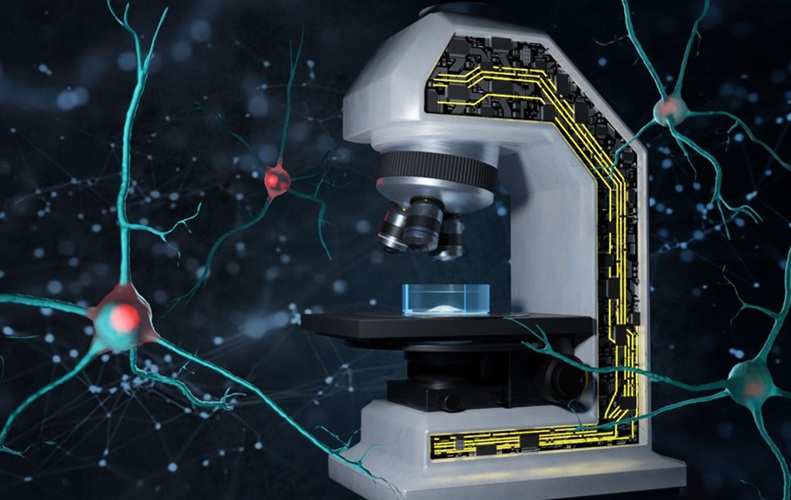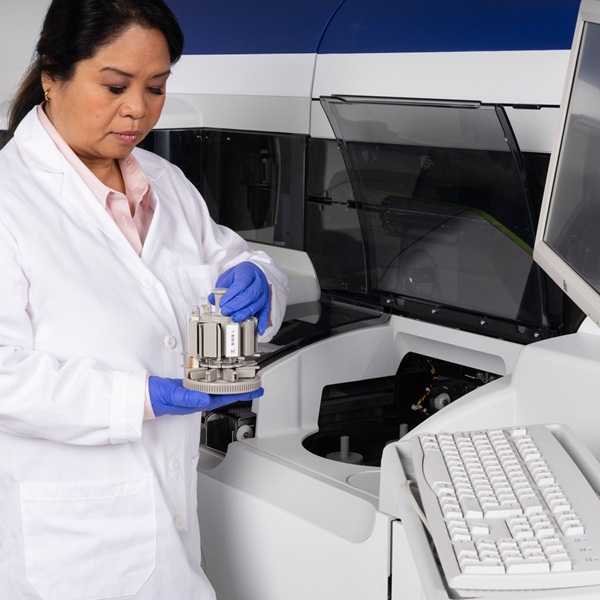Novel POC Troponin Assay Rules Out Acute MI
|
By LabMedica International staff writers Posted on 05 Nov 2018 |

Image: The i-STAT cardiac troponin I assay; healthcare professionals can obtain quantitative measurement of cardiac troponin I (cTnI) in ten minutes without leaving the patient\'s side (Photo courtesy of Abbott Point of Care).
More than seven billion diagnostic tests are run in the USA each year to help physicians make accurate, timely decisions about a person's medical treatment. Emergency department (ED) investigations of patients with suspected acute myocardial infarction (AMI) are time consuming, partly because of the turnaround time of laboratory tests.
Point-of-care diagnostic tests, that can often provide results within minutes, are used globally as hospitals face increased pressures to address overcrowding in emergency rooms and longer wait times. The goal of with-patient diagnostic tests is to deliver results with accuracy similar to the gold standard of high-sensitivity laboratory tests.
A team of scientists collaborating with Christchurch Hospital (Christchurch, New Zealand) evaluated 354 adults, including 255 (72.0%) men; mean age, 62 ± 12 years, who entered an emergency department with symptoms of acute coronary syndrome, such as a heart attack. Troponin concentrations were measured on ED arrival with both a novel point-of-care assay i-STAT TnI-Nx and a high-sensitivity troponin I assay, the Architect hs-cTnI.
The investigators reported that of 354 patients, 57 (16.1%) experienced an AMI. Eighty-five patients (24.0%) presented to the ED less than three hours after symptom onset. No difference was found between the area under the curve (AUC) of the TnI-Nx assay (0.975) and the hs-cTnI assay (0.970). A TnI-Nx assay result of less than 11 ng/L identified 201 patients (56.7%) as low risk, with sensitivity and a negative predictive value of 100%. In comparison, an hs-cTnI assay result of less than 3 ng/L identified 154 patients (43.5%) as low risk, with a sensitivity and a negative predictive value of 100%.
The authors concluded that a novel point-of-care troponin assay that can produce a result 15 minutes after blood sampling had comparable discrimination ability to an hs-cTnI assay for ruling out AMI after a single blood test. Use in the ED may facilitate earlier decision-making and could expedite the safe discharge of a large proportion of low-risk patients. Additional usefulness of this assay is likely to be found outside of the ED, such as in rural hospitals and general practices where there is limited rapid access to laboratory-based troponin assays. The study was published on October 17, 2018, in the journal JAMA Cardiology.
Related Links:
Christchurch Hospital
Point-of-care diagnostic tests, that can often provide results within minutes, are used globally as hospitals face increased pressures to address overcrowding in emergency rooms and longer wait times. The goal of with-patient diagnostic tests is to deliver results with accuracy similar to the gold standard of high-sensitivity laboratory tests.
A team of scientists collaborating with Christchurch Hospital (Christchurch, New Zealand) evaluated 354 adults, including 255 (72.0%) men; mean age, 62 ± 12 years, who entered an emergency department with symptoms of acute coronary syndrome, such as a heart attack. Troponin concentrations were measured on ED arrival with both a novel point-of-care assay i-STAT TnI-Nx and a high-sensitivity troponin I assay, the Architect hs-cTnI.
The investigators reported that of 354 patients, 57 (16.1%) experienced an AMI. Eighty-five patients (24.0%) presented to the ED less than three hours after symptom onset. No difference was found between the area under the curve (AUC) of the TnI-Nx assay (0.975) and the hs-cTnI assay (0.970). A TnI-Nx assay result of less than 11 ng/L identified 201 patients (56.7%) as low risk, with sensitivity and a negative predictive value of 100%. In comparison, an hs-cTnI assay result of less than 3 ng/L identified 154 patients (43.5%) as low risk, with a sensitivity and a negative predictive value of 100%.
The authors concluded that a novel point-of-care troponin assay that can produce a result 15 minutes after blood sampling had comparable discrimination ability to an hs-cTnI assay for ruling out AMI after a single blood test. Use in the ED may facilitate earlier decision-making and could expedite the safe discharge of a large proportion of low-risk patients. Additional usefulness of this assay is likely to be found outside of the ED, such as in rural hospitals and general practices where there is limited rapid access to laboratory-based troponin assays. The study was published on October 17, 2018, in the journal JAMA Cardiology.
Related Links:
Christchurch Hospital
Latest Clinical Chem. News
- Paper Strip Saliva Test Detects Elevated Uric Acid Levels Without Blood Draws
- Prostate Cancer Markers Based on Chemical Make-Up of Calcifications to Speed Up Detection
- Breath Test Could Help Detect Blood Cancers
- ML-Powered Gas Sensors to Detect Pathogens and AMR at POC
- Saliva-Based Cancer Detection Technology Eliminates Need for Complex Sample Preparation
- Skin Swabs Could Detect Parkinson’s Years Before Symptoms Appear
- New Clinical Chemistry Analyzer Designed to Meet Growing Demands of Modern Labs

- New Reference Measurement Procedure Standardizes Nucleic Acid Amplification Test Results
- Pen-Like Tool Quickly and Non-Invasively Detects Opioids from Skin
- Simple Urine Test Could Detect Multiple Cancers at Early Stage
- Earwax Test Accurately Detects Parkinson’s by Identifying Odor Molecules
- First-Of-Its-Kind Quantitative Method Assesses Opioid Exposure in Newborns
- Paper-Based Devices Outperform Existing Methods in Diagnosing Asymptomatic Malaria
- Simple Skin Test Could Revolutionize Diagnosis of Pediatric Eosinophilic Esophagitis
- Portable Diagnostic Tool Uses Bioluminescence to Detect Viruses at POC
- AI-Powered Lung Maturity Test Identifies Newborns at Higher Risk of Respiratory Distress
Channels
Molecular Diagnostics
view channel
AI-Powered Cytology Tool Detects Early Signs of Oral Cancer
Each year, 54,000 Americans are diagnosed with oral cancer, yet only 28% of cases are identified at an early stage, when the five-year survival rate exceeds 85%. Most diagnoses occur in later stages, when... Read more
Non-Invasive Liquid-Based Cytology Test Enables Early Endometrial Cancer Detection
Endometrial cancer is the fourth most common cancer among women in the United States, with over 69,000 new cases expected in 2025. Yet many diagnoses occur late, particularly in women who face inconclusive... Read more
Bioluminescent Molecular Diagnostics Platform Enables Rapid On-Site Pathogen Detection
Infectious diseases such as malaria, gonorrhea, and chlamydia continue to pose serious global health challenges, particularly in low-income countries with limited healthcare infrastructure.... Read more
Comprehensive Genomic Testing Reveals Treatment Targets In 90% Of Advanced Solid Tumors
Patients with advanced solid tumors often face limited treatment options, in part because conventional testing methods fail to detect many of the genetic mutations that could guide targeted therapies.... Read moreHematology
view channel
Portable and Disposable Device Obtains Platelet-Rich Plasma Without Complex Equipment
Platelet-rich plasma (PRP) plays a crucial role in regenerative medicine due to its ability to accelerate healing and repair tissue. However, obtaining PRP traditionally requires expensive centrifugation... Read more
Disposable Cartridge-Based Test Delivers Rapid and Accurate CBC Results
Complete Blood Count (CBC) is one of the most commonly ordered lab tests, crucial for diagnosing diseases, monitoring therapies, and conducting routine health screenings. However, more than 90% of physician... Read moreImmunology
view channel
Precision Tool Predicts Immunotherapy Treatment Failure in Melanoma Patients
Melanoma, though accounting for only about 4% of skin tumors, is the deadliest form of skin cancer due to its high potential to metastasize. While immunotherapy, especially PD-1 protein blockade, has revolutionized... Read more
Paper-Based Device Accurately Detects Immune Defects in 10 Minutes
Patients with hidden immune defects are especially vulnerable to severe and persistent infections, often due to autoantibodies that block interferon-gamma (IFN-γ), a key molecule in immune defense.... Read more
New AI System Uncovers Hidden Cell Subtypes to Advance Cancer Immunotherapy
To produce effective targeted therapies for cancer, scientists need to isolate the genetic and phenotypic characteristics of cancer cells, both within and across different tumors. These differences significantly... Read more
Evolutionary Clinical Trial to Identify Novel Biomarker-Driven Therapies for Metastatic Breast Cancer
Metastatic breast cancer, which occurs when cancer spreads from the breast to other parts of the body, is one of the most difficult cancers to treat. Nearly 90% of patients with metastatic cancer will... Read moreMicrobiology
view channel
Saliva Test Detects Implant-Related Microbial Risks
Infection is the most frequent and preventable cause of dental implant failure, with microbial organisms contributing to inflammation, tissue degradation, and systemic immune response—often without visible... Read more
New Platform Leverages AI and Quantum Computing to Predict Salmonella Antimicrobial Resistance
Antimicrobial-resistant Salmonella strains are a growing public health concern due to the overuse of antimicrobials and the rise of genetic mutations. Accurate prediction of resistance is crucial for effective... Read more
Early Detection of Gut Microbiota Metabolite Linked to Atherosclerosis Could Revolutionize Diagnosis
Cardiovascular disease is the leading cause of death worldwide, and atherosclerosis plays a critical role in its development. This chronic condition, characterized by the hardening and narrowing of arteries... Read morePathology
view channel
Novel Method To Analyze Tumor Growth Rates Helps Tracks Progression Between Diagnosis and Surgery
Patients diagnosed with breast cancer often worry about how quickly their tumors grow while they wait for surgery, and whether delays in treatment might allow the disease to spread beyond the point of cure.... Read more
Novel Technology Detects Key Mutations from Blood Samples in Metastatic Colorectal Cancer Patients
Accurate and timely mutation profiling in patients with metastatic colorectal cancer is critical for effective treatment monitoring and relapse detection. However, conventional approaches often rely on... Read more
Self-Driving Microscope Tracks and Analyzes Misfolded Protein Aggregation in Real Time
The accumulation of misfolded proteins in the brain is central to the progression of neurodegenerative diseases like Huntington’s, Alzheimer’s, and Parkinson’s. Yet to the human eye, proteins that are... Read moreTechnology
view channel
New Microfluidic System Enables Early Cancer Diagnosis Using Simple Blood Tests
Circulating tumor cells (CTCs), which break off from primary tumors and travel through the bloodstream, pose a significant risk by forming secondary tumors in other organs. Detecting and analyzing these... Read more
AI to Transform Skin Cancer Diagnosis in Remote Areas
Many patients living in remote regions lack timely access to dermatological care, often facing long wait times and delayed diagnoses for potentially serious conditions like skin cancer. Healthcare backlogs... Read moreIndustry
view channel
IFCC WorldLab 2026 To Be Held in India on October 25-29
The International Federation of Clinical Chemistry and Laboratory Medicine (IFCC, Milan, Italy) will hold its 27th International Congress of Clinical Chemistry and Laboratory Medicine (IFCC WorldLab 2026)... Read more


















